How to write a research proposal using ChatGPT
If you want to use ChatGPT for your research proposal writing, you can do this for free by creating an account with OpenAI, the company behind the popular tool.
Next, you’ll need to effectively apply prompts to ChatGPT that support the structure and direction of the research paper you propose to write.
Here’s how to do it!
Note:
While this article will show you how to use ChatGPT for a research proposal writing, PandaDoc has recently launched Panda AI, our text block writing assistant, which is also powered by OpenAI. And you can get an extra jump ahead by starting your project with a research proposal template.
Step 1: Get ChatGPT familiar with the research proposal topic
Have a ChatGPT learn and analyze the topic before starting writing other sections.
Doing so will help the AI provide the most accurate and relevant answers.
Let’s say your research proposal topic is: Investigating the Impact of Virtual Reality in Surgical Outcomes.
Here is how the prompt may look:
“I’m currently working on a research proposal that explores the effects of virtual reality (VR) on learning outcomes in the context of surgery education.
I want to show the reader how immersive VR experiences can enhance surgery procedures and overall training outcomes.
Can you please provide me with insights on the potential benefits of VR in surgery education, and any suggestions for methodologies to assess learning outcomes using VR?.”
Here is how the answer may appear:

In this prompt, you’ve provided specific details about your research proposal topic, your objectives, and the aspects you’re interested in exploring.
By doing so, you’re guiding ChatGPT to generate responses that are directly relevant to your research area.
Make sure to adapt the prompt to match your own research proposal topic, objectives, and interests.
Step 2: Ask ChagtGPT to suggest an introduction
Once ChatGPT is familiar with the topic, you can start writing sections.
Please note that below we are going to showcase only those sections where ChatGPT as a tool will be the most effective and safe to use.
These sections though will still require you to add a human touch, personal thoughts and perform fact-checking.
The first section of the research proposal will be an introduction.
Here is how a possible prompt may look:
“Please generate an engaging introduction that highlights the importance of investigating the impact of virtual reality (VR) on surgical outcomes. Can you please also discuss and mention the relevance of surgical training and the potential for VR to revolutionize the medical field. Please also include a concise overview of the current issues in surgical training and the gap that my research aims to address.”
And here is a possible answer:
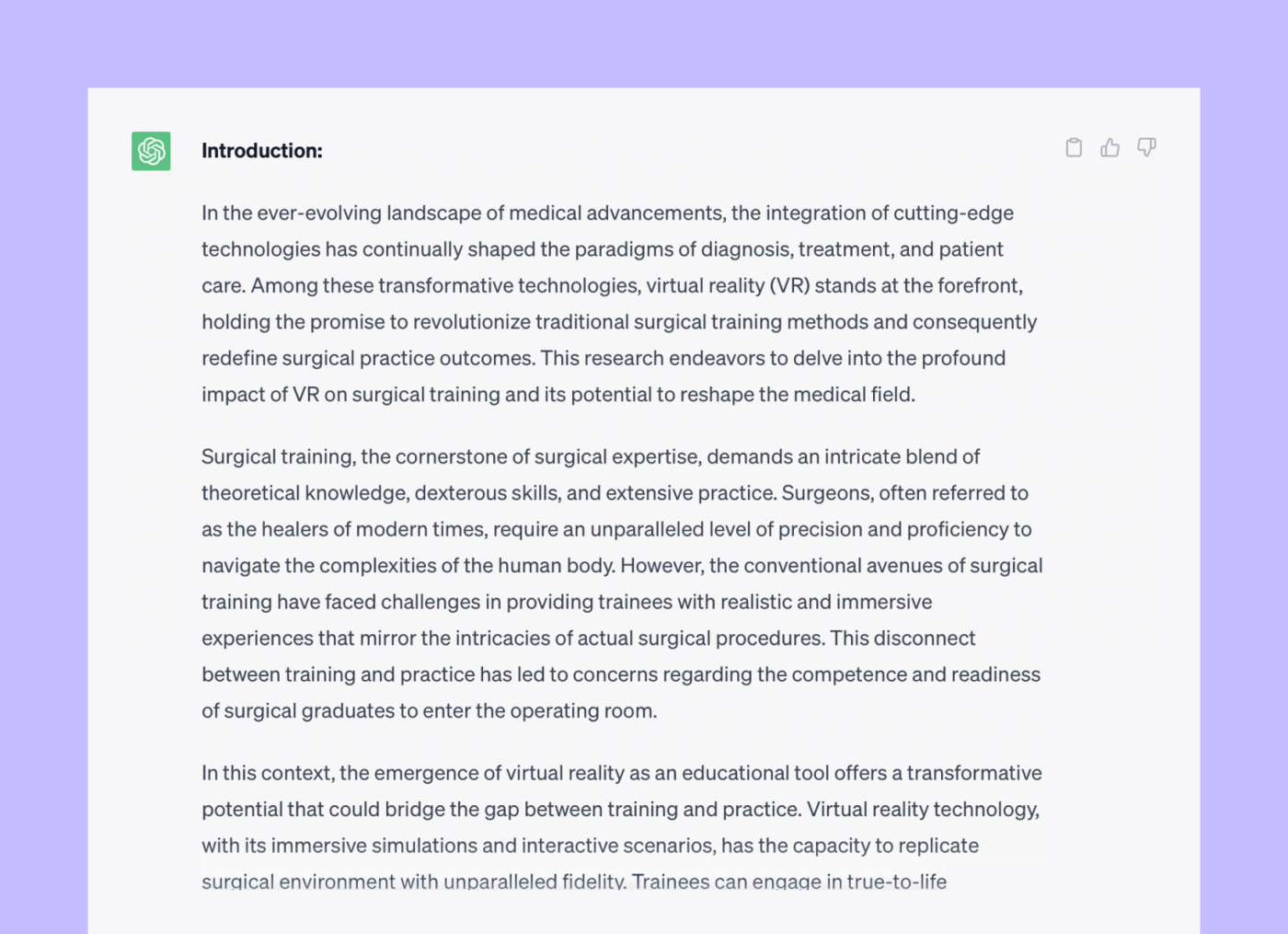
Step 3: Generate a research objectives section
Here you can use ChatGPT to assist you in formulating objectives of your research to test several options offered by an AI and go further with the one (or more) you find most relevant and promising in your specific case.
Here is a prompt that follows our VR in surgery theme:
“Please generate an accurate Research Objectives section that outlines the specific aims and goals of my study investigating the impact of virtual reality (VR) on surgical outcomes.
Clearly define the overarching purpose of the research, including assessing the effectiveness of VR-assisted training in enhancing surgical skills and increasing its influence on surgical precision as well as error reduction.”
Here is how our answer may appear:
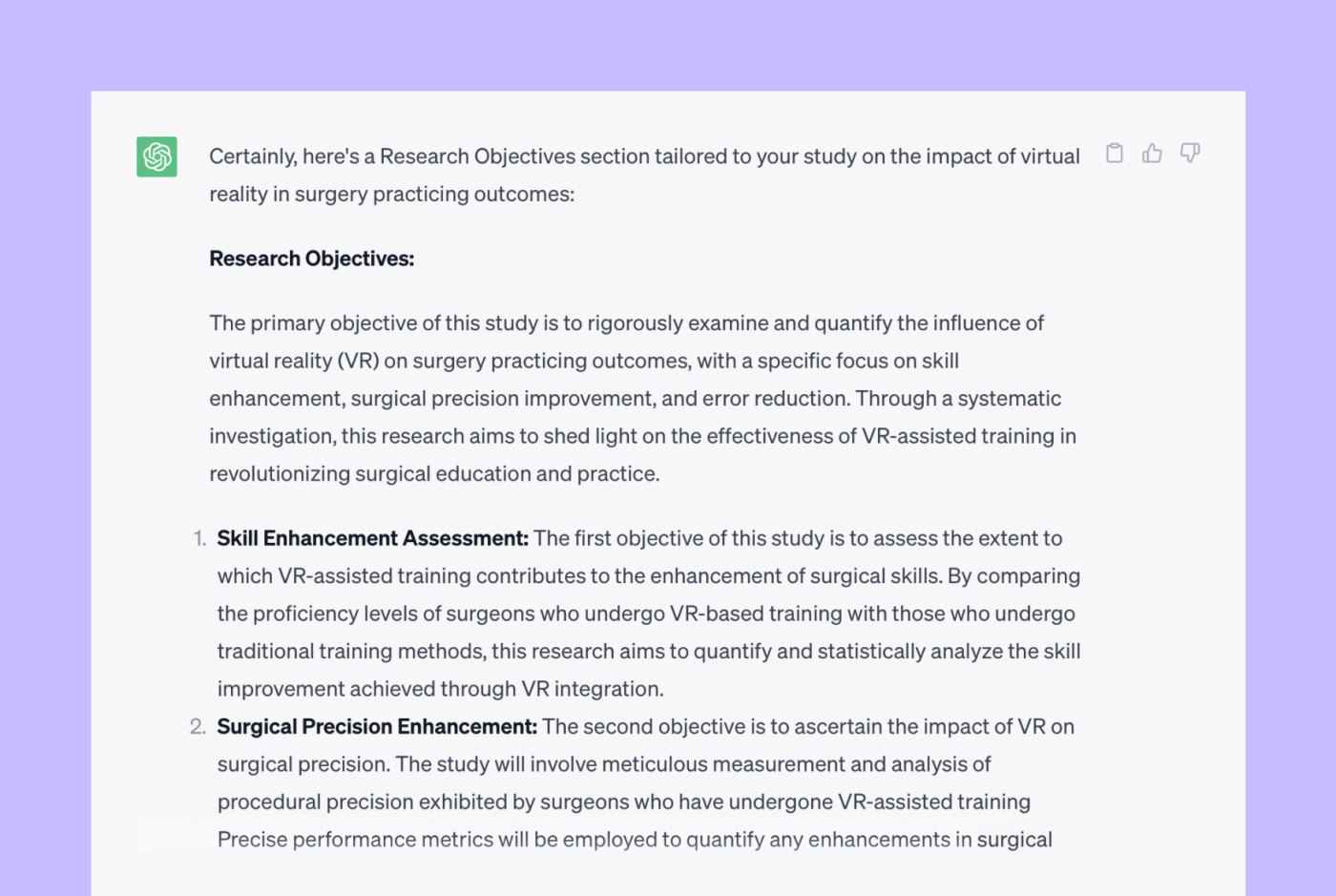
In this prompt, you’ve provided specific purposes of your research and aspects you are interested in the most.
By doing so, you guide ChatGPT to generate more accurate and relevant responses.
Step 4: Use ChatGTP to gain insights on a literature review section
Have ChatGPT collect literature relevant to your research proposal topic, so you can avoid wasting time on exploring numerous web pages searching for the most useful links.
Please note that ChatGPT doesn’t always provide relevant and trustworthy data when it comes to literature, studies and research.
That is because it is trained on data up to September 2021. So double checking the data provided before is a must-have.
Here is our prompt:
“Can you please compose a literature review that examines the existing body of research on the topic: Use of VR in surgical training. Collect relevant latest studies that highlight the benefits of VR, methodologies employed to assess its impact, and any gaps in the current understanding of its effects on surgical outcomes.”
And the answer that came back:
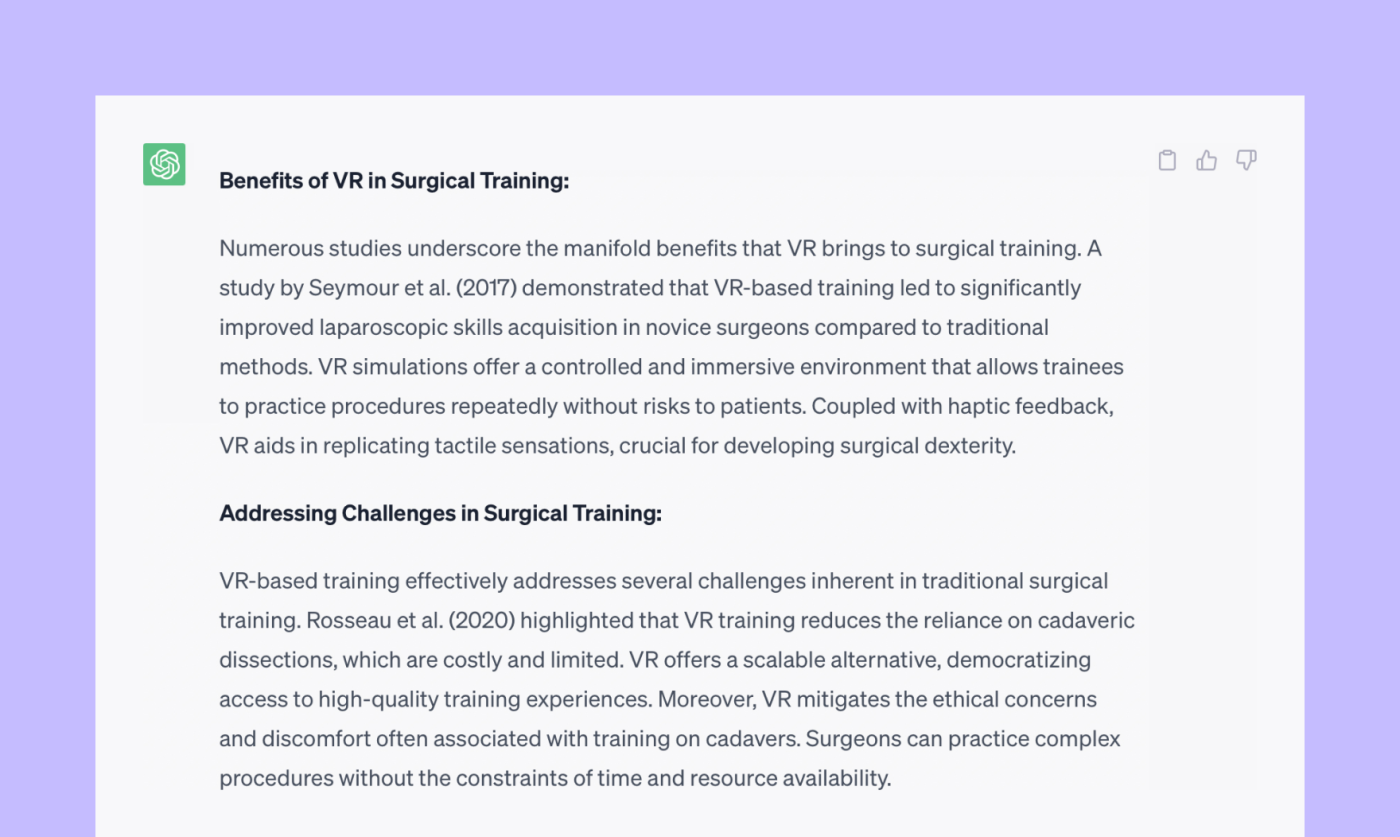
Step 5: Generate research questions or hypotheses
At this stage you can use ChatGPT to formulate specific questions or form an hypothesis to guide you through research.
Here is how a prompt may look for our topic theme:
“Please formulate well-defined research questions and hypotheses that encapsulate several aspects of the impact of virtual reality on surgical practice outcomes that I am going to explore. Focus on questions related to skill acquisition, error reduction and performance improvement.”
And the answer that came back:
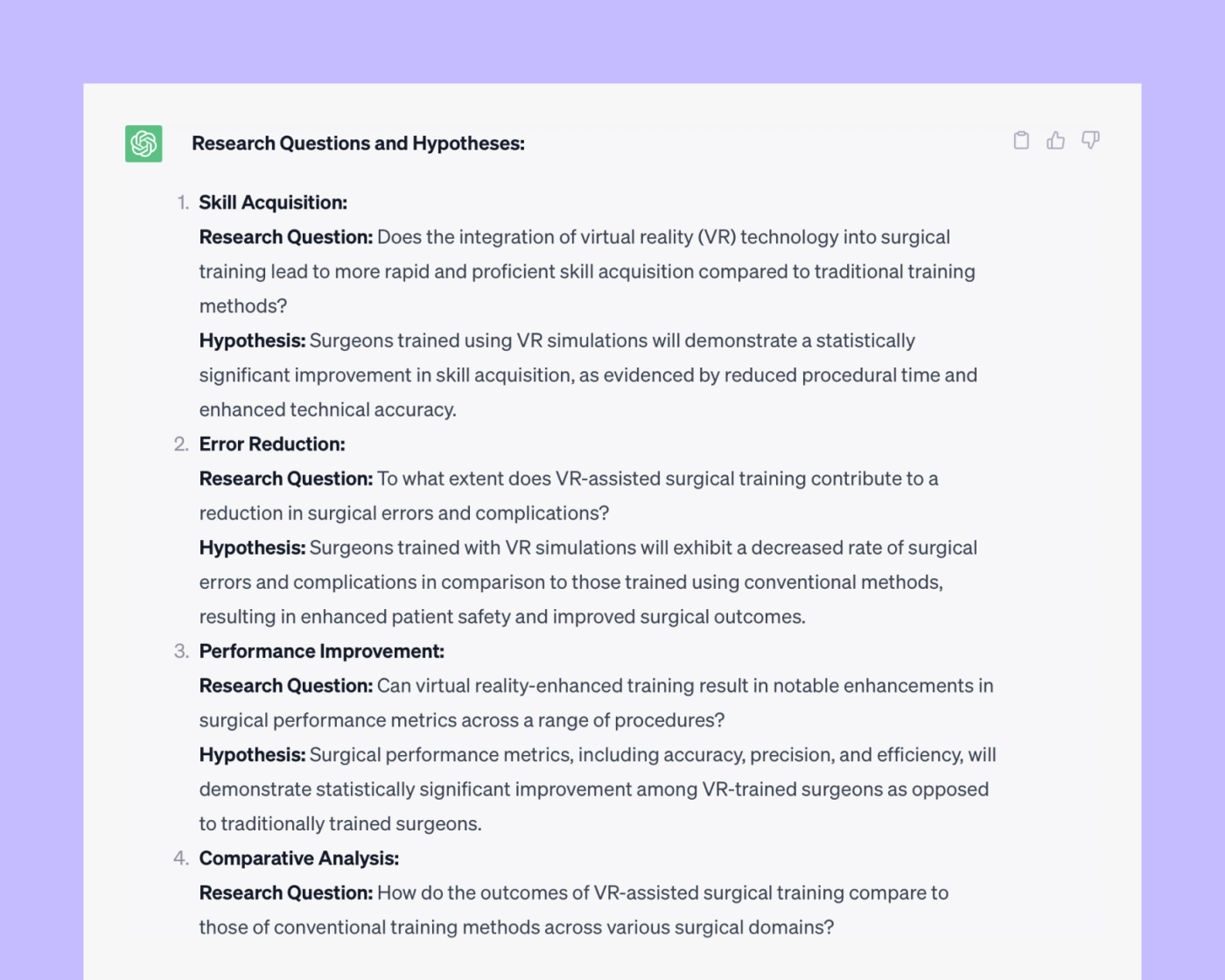
Step 6: Use ChatGPT to suggest data collection and analysis section
Here you can feed ChatGPT with data you collected manually and ask the tool to help formulate the answer in a direct and informative way.
Let’s say:
- Your data collection methods were surveys in private clinics and hospitals that already use VR in surgical training.
- The type of data you intend to gather is feedback from surgeons that have undergone VR training and statistics on whether the surgery outcomes were improved or not.
- The techniques you use to analyze the data are factor analysis, cohort analysis and cluster analysis.
Here is how your prompt may look:
“Please elaborate on the data collection process and the type of data I am going to gather. Specify the criteria for evaluating efficiency, precision, and techniques I will use to analyze the collected data. Consider discussing potential challenges and how I plan to address them.”
Here is one possible answer:

Step 7: Generate a conclusion
Once all sections are written and reviewed for data accuracy, plagiarism and mistakes, you can upload the research proposal into ChatGPT and ask it to write a conclusion.
Here is our prompt:
“Generate a concluding section that will summarize the key points of the proposal topic and finalize key thoughts. Emphasize the importance of continued study in using surgical training methodologies and how VR can shape the future of medical education via VR integration.”
Here is how the answer may appear:
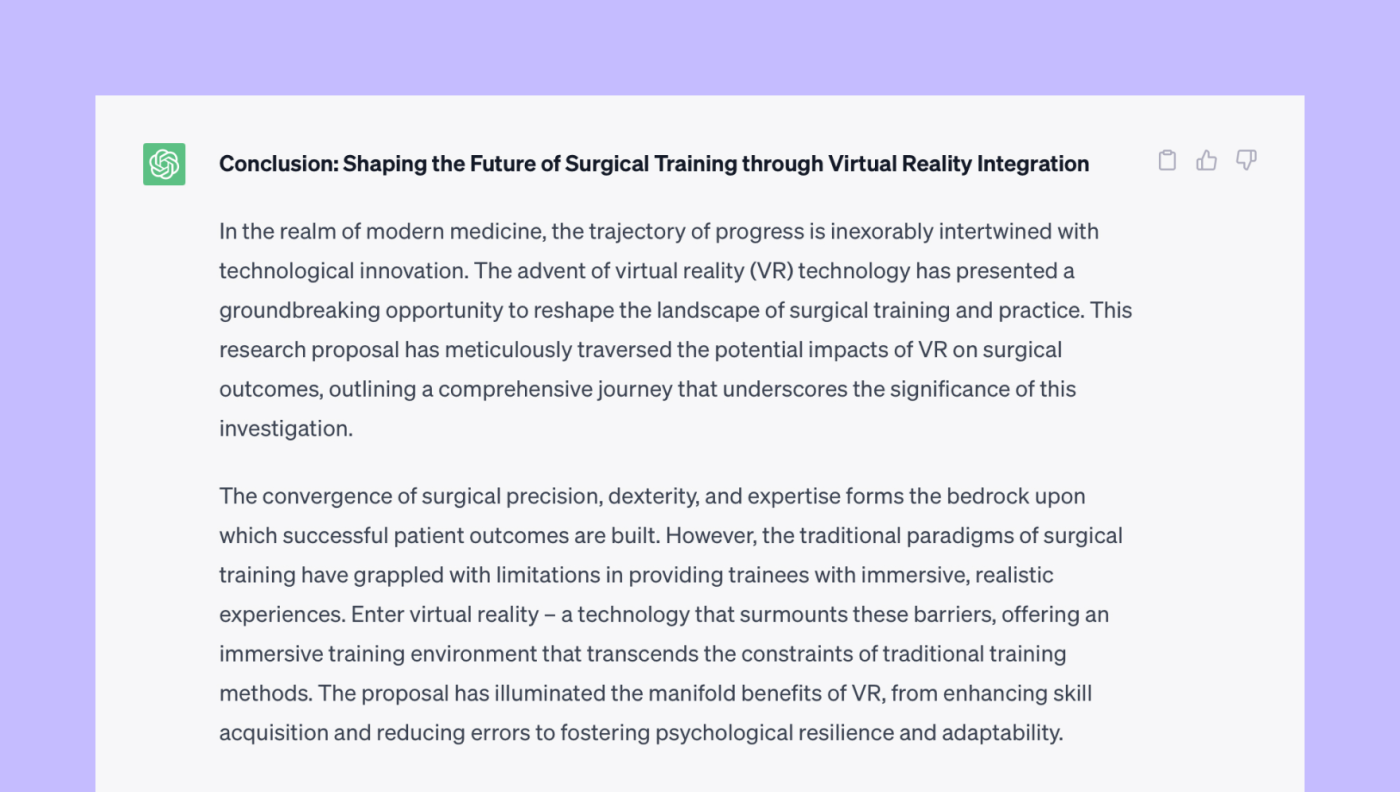
Step 8: Check for inaccuracies and plagiarism
Always validate and fact-check instead of simply relying on any information ChatGPT offers up — it’s a powerful tool, but it has already garnered a reputation for occasionally “hallucinating.”
Lastly, any info you obtain from ChatGPT — especially content you intend to work with and someday put your name on — should be run through a plagiarism checker, full stop.
Write, send and manage research proposals with ChatGPT using PandaDoc
The entire research proposal writing process can be streamlined using PandaDoc.
Begin by choosing from a library of proposal templates to quickly choose a proper structure, and opt for using Panda AI to help generate ideas and fill sections.
The PandaDoc platform will support you every step of the way. Sign up or schedule a demo today!

